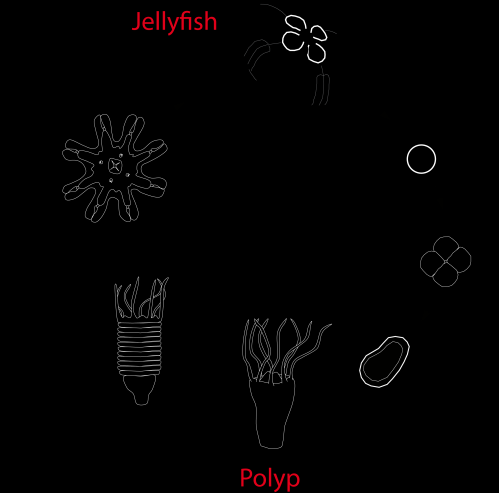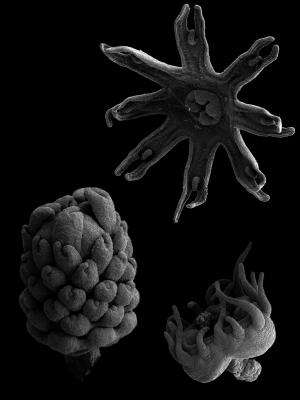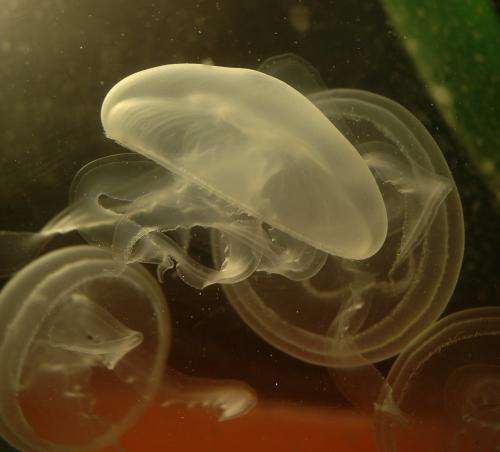The life cycle of Aurelia contains two alternating generations - polyps and jellyfish. In the spring, each polyp transforms into multiple young jellyfish that detach from each other and start their independent life. Fertilized eggs produced by adult jellyfish develop into larvae, which settle down and transform into polyps.
How does one genome create two completely different body plans in one animal? This was the question Konstantin Khalturin was attempting to answer when he began working on jellyfish. The fascinating story he discovered along the way answers questions about the regulation of metamorphosis, an animal changing from one physical form to another, in the moon jellyfish Aurelia aurita. In the February 3rd edition of Current Biology, Khalturin and colleagues working at the Zoological Institute in Kiel, Germany described a new hormone responsible for metamorphosis in jellyfish and linked it to a common developmental biology pathway found in more complex animals.
Early in development, jellyfish exist as a polyp, a stationary form that anchors to the bottom of the ocean and reproduces asexually. When the temperature of the ocean drops during the winter months for a certain amount of time, the polyps begin metamorphosis when individual layers of the polyp bud off and begin turning into the familiar jellyfish form. This process is called strobilation, and the polyp at this stage is called a strobila. The genes responsible for metamorphosis between polyp and jellyfish remained a mystery until now. The researchers started by feeding the transitioning strobila, the actively budding part, to polyps to see if there was some substance present in the strobila that could induce metamorphosis. The data suggested this was true, and polyps fed with strobila underwent metamorphosis without the drop in temperature normally required. The researchers determined that some substance that could move out of the strobila into the surrounding polyp was inducing metamorphosis, giving them a clue as to what type of gene they should look for.
The next step was looking at what genes were expressed exclusively during the strobila phase. They identified three excellent candidates. One of which, called CL390, fits all of their requirements: it was expressed in the strobila stage, was turned on when the water temperature dropped and increased in expression as the temperature continued to stay cold. The researchers observed that there was a threshold of time that the water temperature needed to be low in order for polyps to undergo metamorphosis. They hypothesized that this would prevent the polyps from transitioning to jellyfish too early in winter and not having a sufficient food source. CL390 seemed to act as a timer, informing the polyp when the temperature was low for long enough, meaning winter was almost over and that it was time to undergo metamorphosis. When CL390 reached a threshold of 15 times its expression during polyp stage, metamorphosis occurred even if the researchers had transferred the polyps back to a higher temperature.
Stages of jellyfish metamorphosis seen using an electron microscope, featured on the cover of Current Biology. You can see the polyp on the bottom right, the strobila and the immature jellyfish at the top.
The researchers also discovered a link between metamorphosis and retinoic acid, a compound derived from Vitamin A required in development throughout the animal kingdom. They linked the role of retinoic acid and one of its nuclear hormone receptors to the CL390 gene, demonstrating that some common features of higher order animal development are conserved in these much simpler animals.
Adult moon jellyfish Aurelia aurita.
Khalturin has recently joined the Marine Genomics Unit of OIST and continues to work on Aurelia aurita with a goal to further understand his original question, how does one genome create two body plans? In addition to contributing to our understanding of metamorphosis, this work also has practical applications. Since they have identified one of the key elements responsible for creating jellyfish from polyps, it may be possible to use this information to prevent jellyfish blooms that have become common in recent years and can devastate fish populations.
More information: "Regulation of Polyp-to-Jellyfish Transition in Aurelia aurita." Björn Fuchs, Wei Wang, Simon Graspeuntner, Yizhu Li, Santiago Insua, Eva-Maria Herbst, Philipp Dirksen, Anna-Marei Böhm, Georg Hemmrich, Felix Sommer, Tomislav Domazet-Lošo, Ulrich C. Klostermeier, Friederike Anton-Erxleben, Philip Rosenstiel, Thomas C.G. Bosch, Konstantin Khalturin. Current Biology - 16 January 2014. DOI: 10.1016/j.cub.2013.12.003
Journal information: Current Biology
Provided by Okinawa Institute of Science and Technology


























